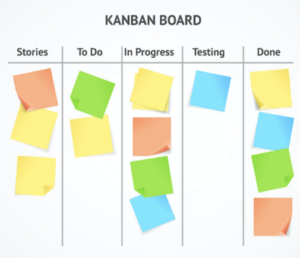Table of Contents
ToggleLimit Work In Progress (WIP)
- Enhanced Focus and Productivity: By limiting the number of tasks any one individual or team handles at a time, there is a sharper focus, which often leads to increased productivity and quality of work. This concentrated effort ensures that tasks are completed more efficiently and effectively.
- Blocker Identification and Resolution: A smaller WIP load makes it easier to identify and address bottlenecks or blockers in the process. When these issues are quickly spotted, the team can collaboratively work towards resolving them, ensuring smoother workflow.
- Frequent Delivery of Value: With a focus on completing a few tasks at a time, the team can deliver value more frequently. This continuous delivery model allows for rapid iterations and adjustments based on feedback, ensuring that the final product is closely aligned with customer needs and expectations.
- Faster Feedback Loop: Smaller work batches lead to a faster feedback loop. The team can quickly learn from completed tasks and apply these insights to future work, enhancing the overall quality and efficiency of the supply chain process.
- Predictability in Deliverables: Limiting WIP leads to more predictable outcomes. With fewer tasks in progress at any given time, it becomes easier to estimate completion times and manage expectations both within the team and with stakeholders.
- Enforcing T-Shaping of Team Members: This approach encourages team members to develop a range of skills (T-shaped skills), where they have deep expertise in at least one area but are also capable of contributing to other tasks. This cross-functional skill set enhances team versatility and resilience.
- Improves Team Morale and Reduces Burnout: With a more manageable workload and clearer focus, team members are less likely to experience burnout. This approach supports a more sustainable and enjoyable working environment.
- Resource Optimization: By limiting WIP, resources are utilized more effectively. This optimization ensures that the team’s capacity is not overstretched, and resources are allocated to where they are most needed.
Start just in time with Lean Kanban
Balance small batches and fixed costs

Pic.1. Lean Kanban
Conlusions: Lean Kanban
Lean Kanban stands as a dynamic and effective approach to streamline work processes across various sectors. Its fusion of Lean and Kanban methodologies significantly boosts efficiency and productivity. Lean Kanban is not just about using a board; it’s a comprehensive strategy that includes managing work in progress, enhancing focus, and continually delivering value.
By implementing limits on Work In Progress (WIP), teams experience numerous advantages. These include improved cycle times, reduced context switching, and enhanced productivity. Focusing on a few priority items at a time ensures a deeper concentration, leading to higher quality work. This approach also facilitates quicker identification and resolution of blockers, fostering a collaborative environment where team members work together to overcome challenges.
A significant benefit of Lean Kanban is the frequent delivery of value. Concentrating on fewer tasks allows teams to deliver outputs more regularly, enabling swift iterations and adjustments based on feedback. This leads to products and services that align closely with customer needs and expectations.
Another key aspect is the faster feedback loop. Smaller work batches mean quicker learning from completed tasks, enhancing the quality and efficiency of future work. This approach also results in more predictable deliverables, making it easier to manage timelines and expectations.
The strategy of starting features “just in time” rather than “as early as possible” plays a critical role in reducing context switching and enhancing clarity. This timing ensures that features are well-understood and feedback is incorporated before they enter the workflow.
In balancing small batches with fixed costs, Lean Kanban urges a careful evaluation of when batching is more effective than one-piece flow. Teams are encouraged to find the sweet spot where batch sizes are manageable yet large enough to necessitate automation for cost-efficiency.
Stefan Stojković is an experienced Project Manager and Agilist with a demonstrated history of working in the automotive industry, kids IT Education, Software development, and Agile transformations in non-IT industries. Skilled in management, negotiations, manufacturing, development, and knowledge transfer.







